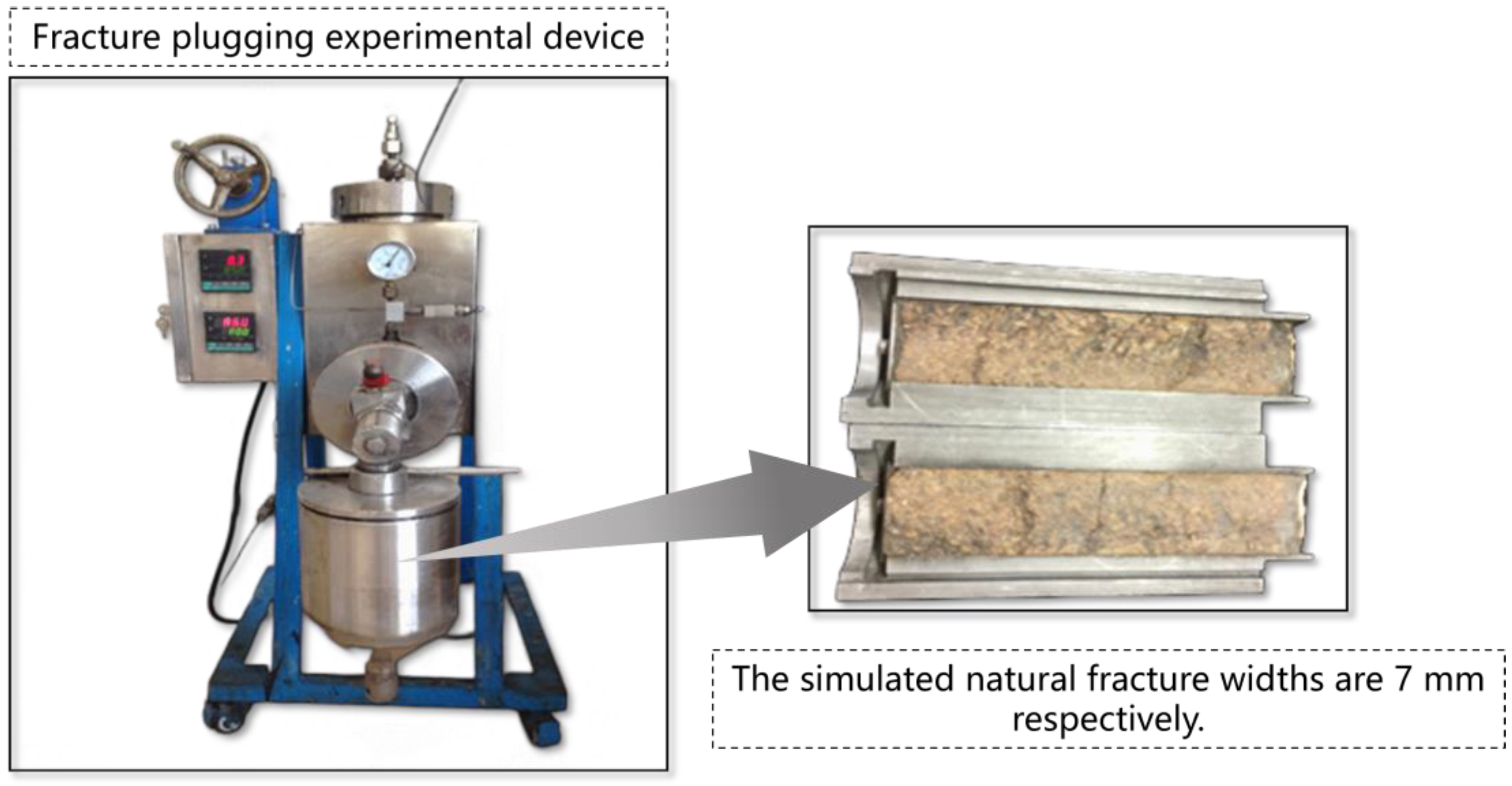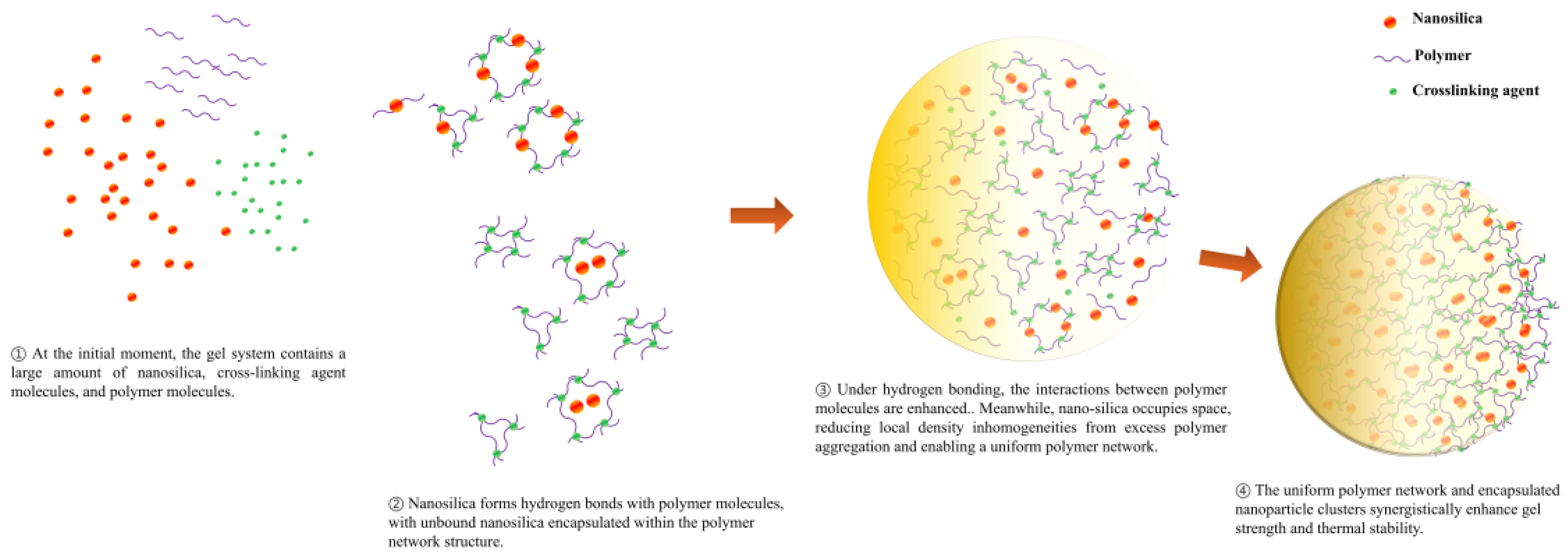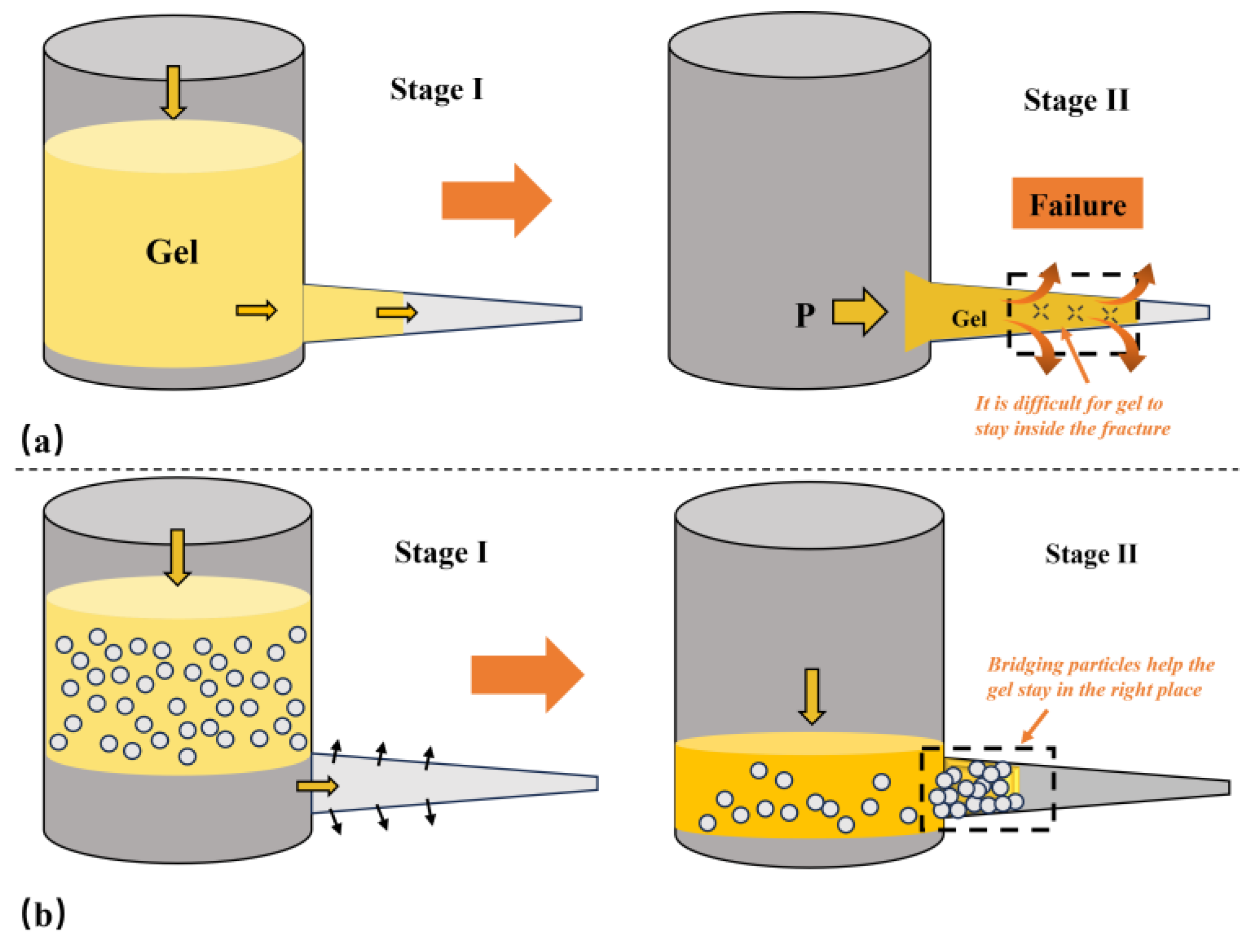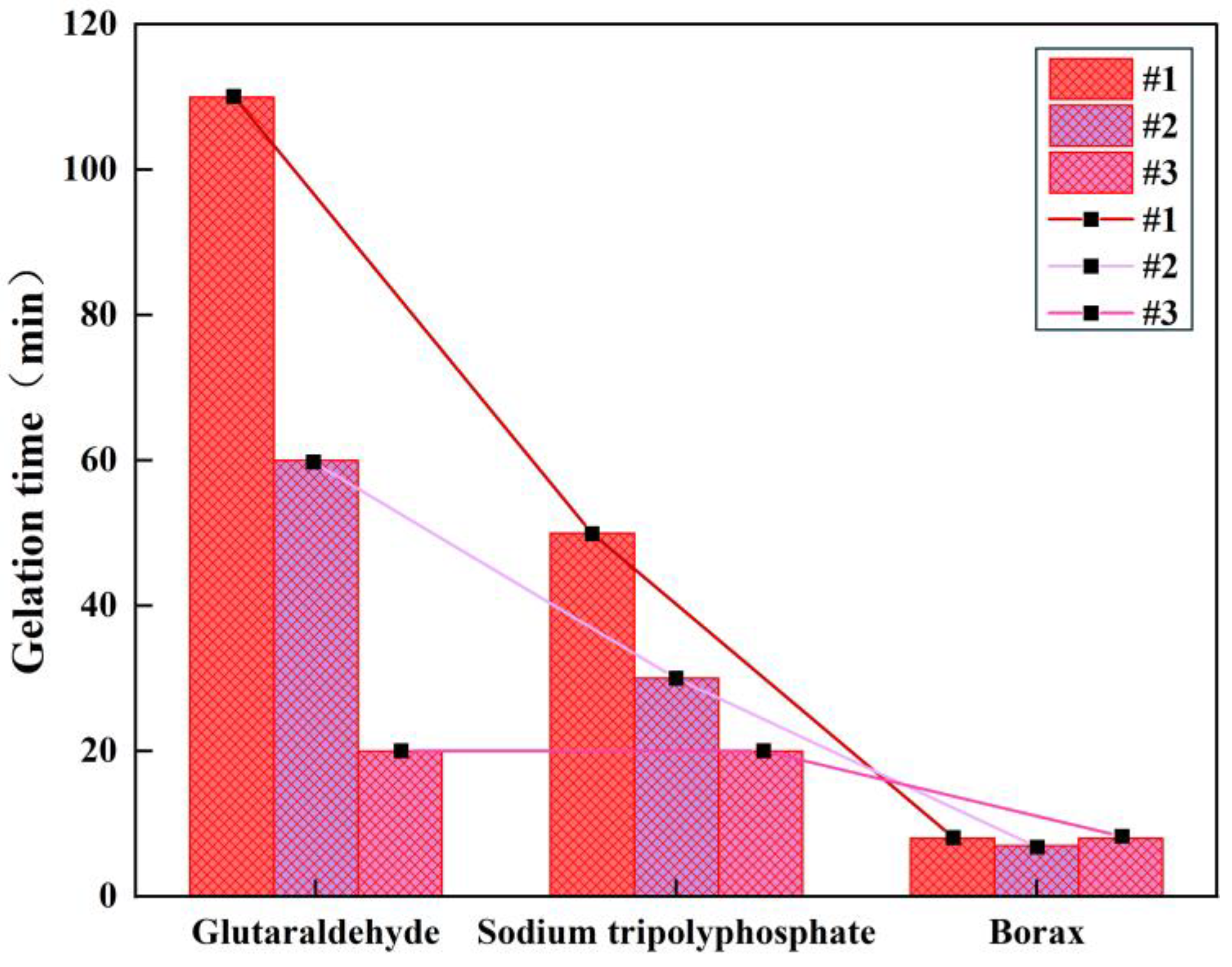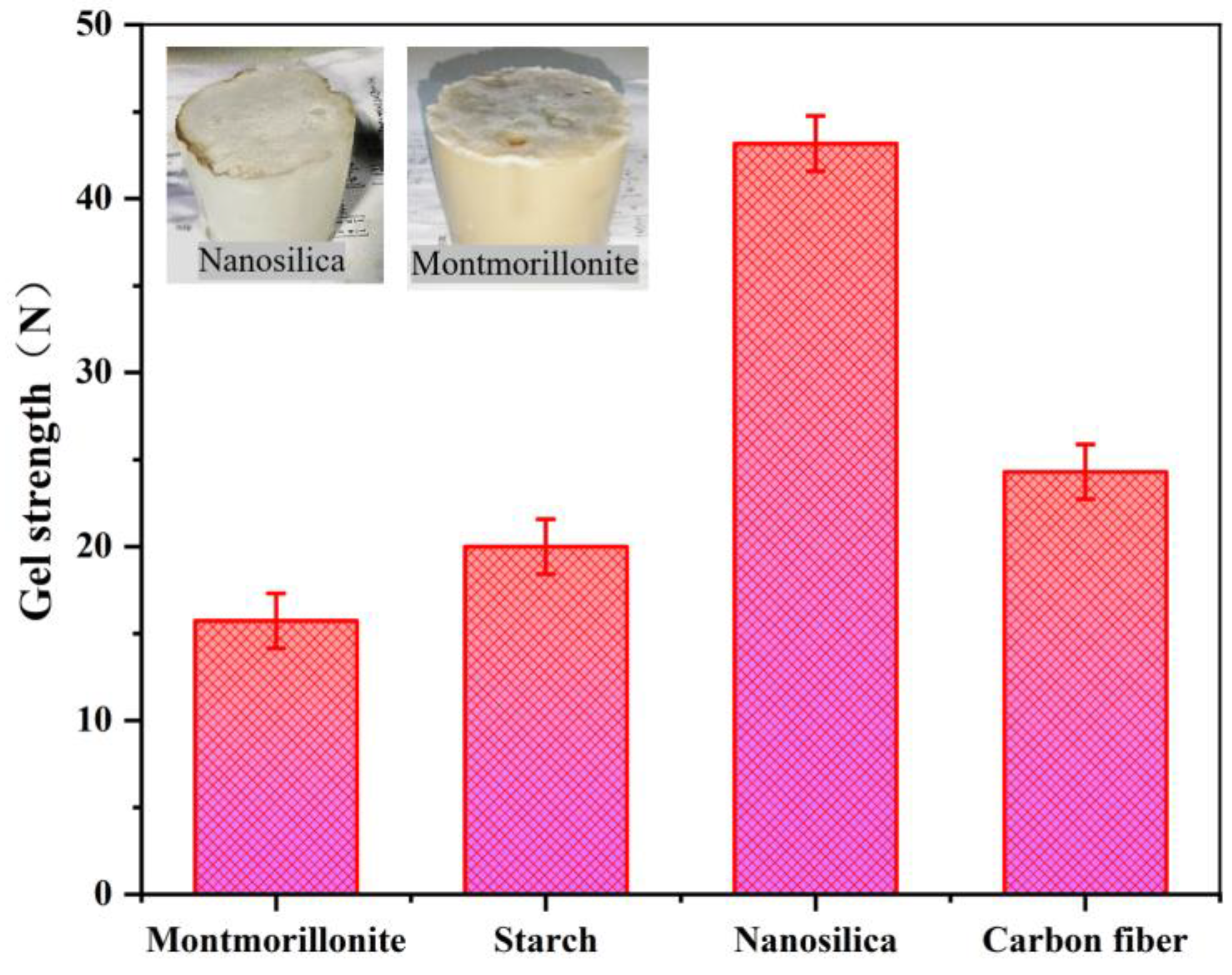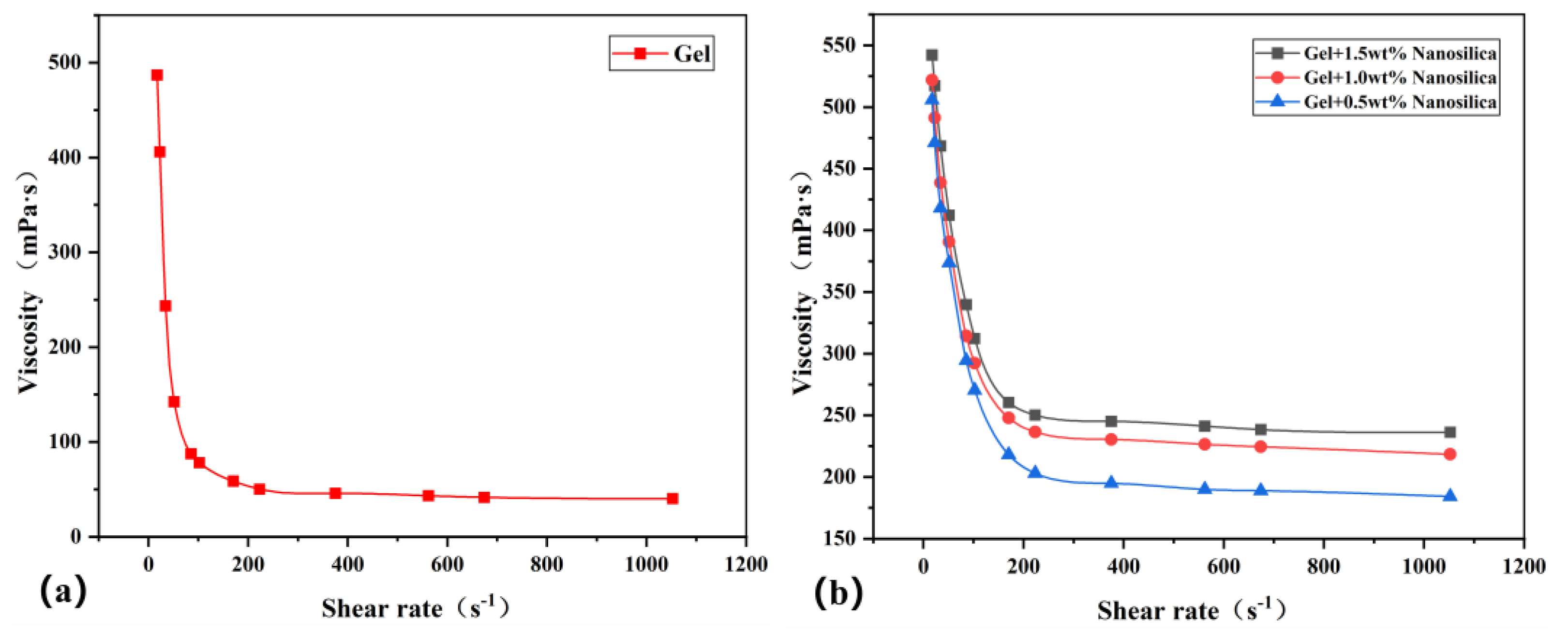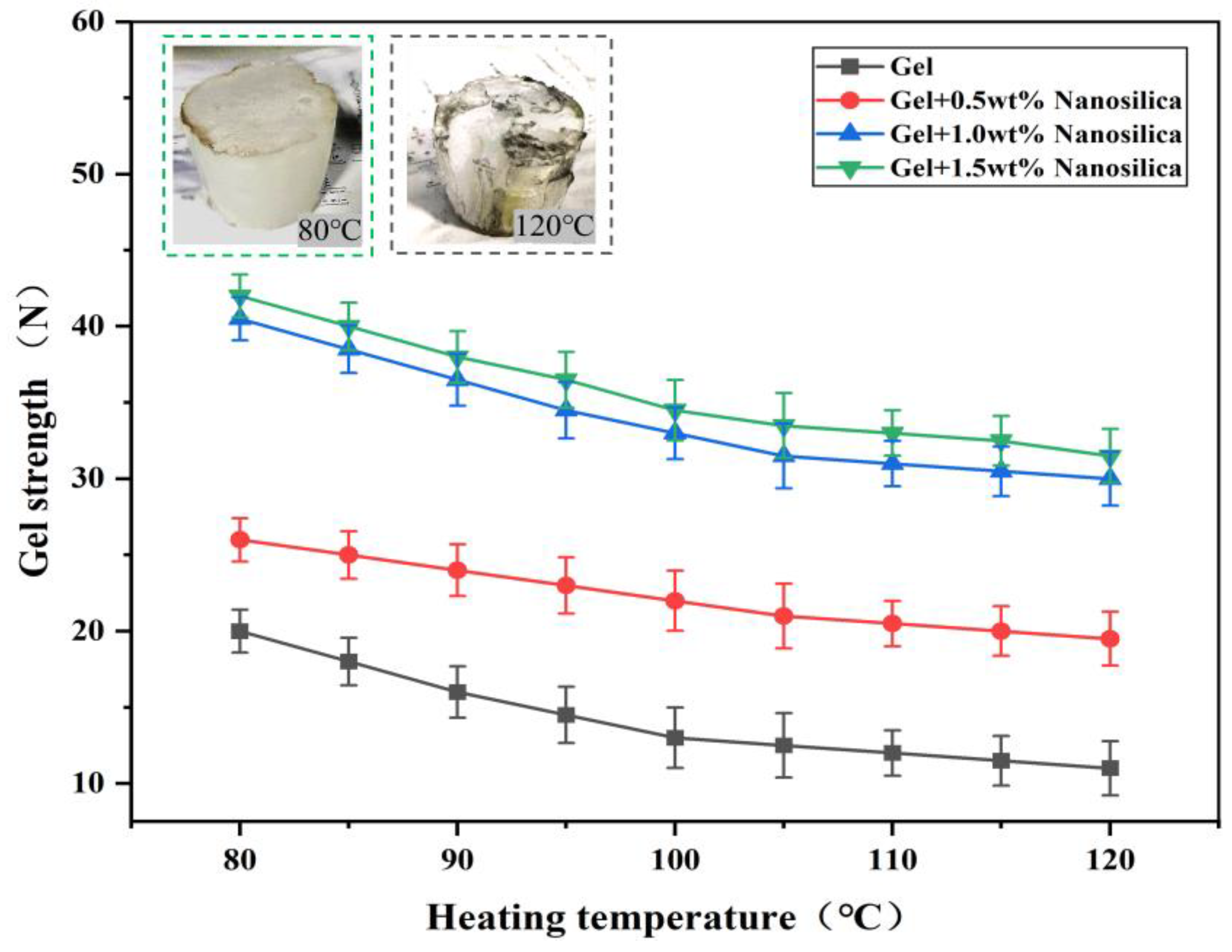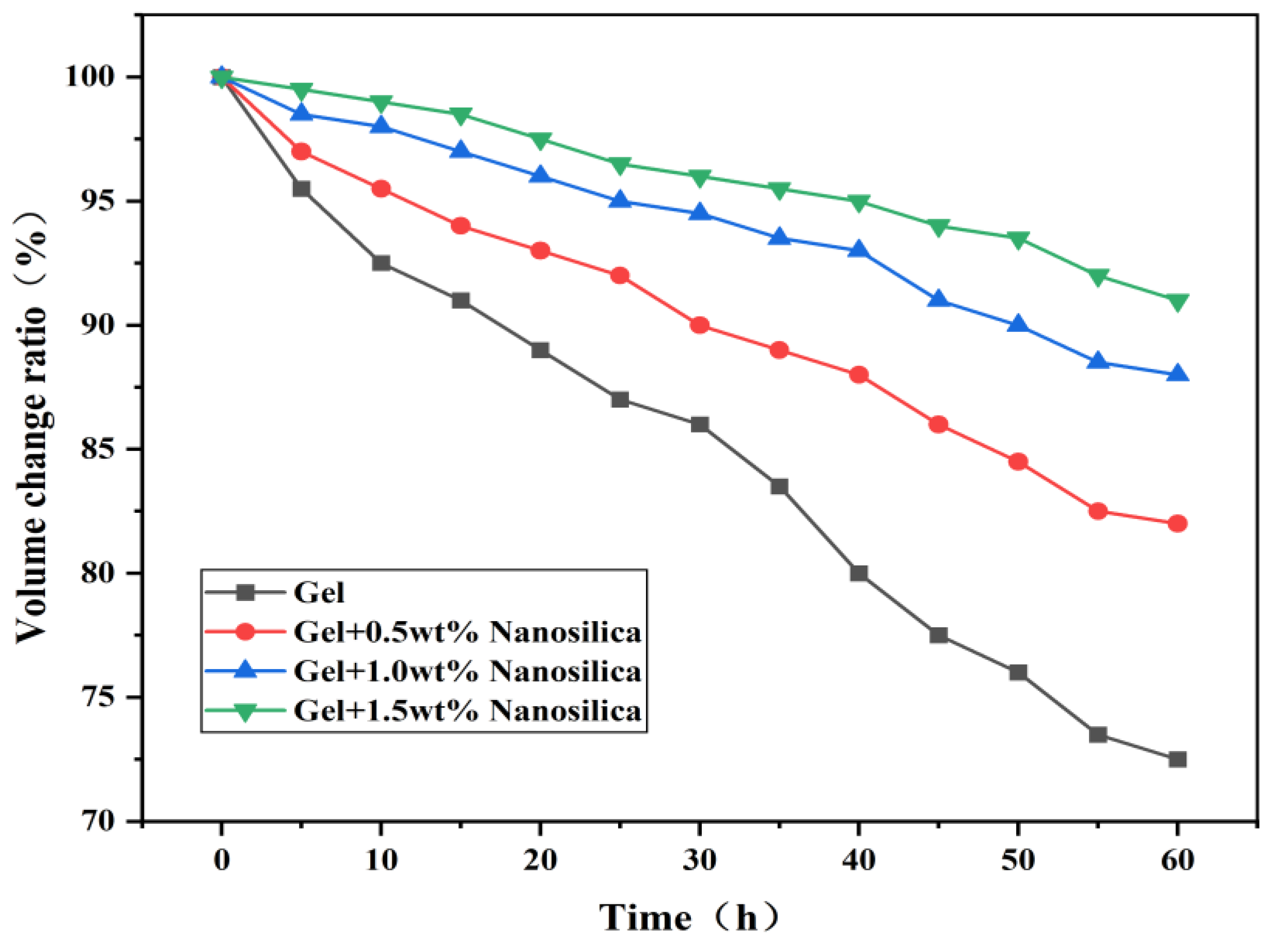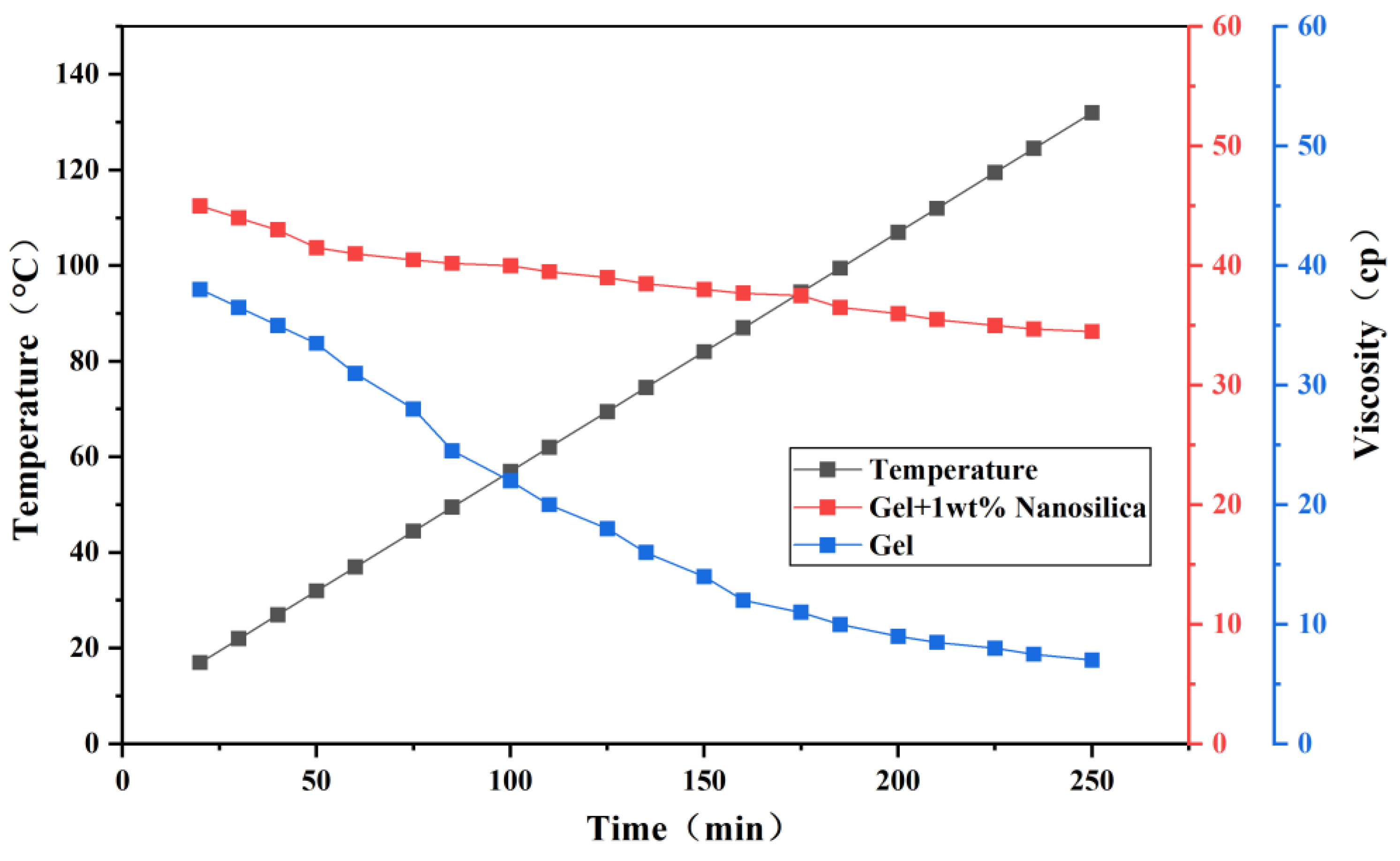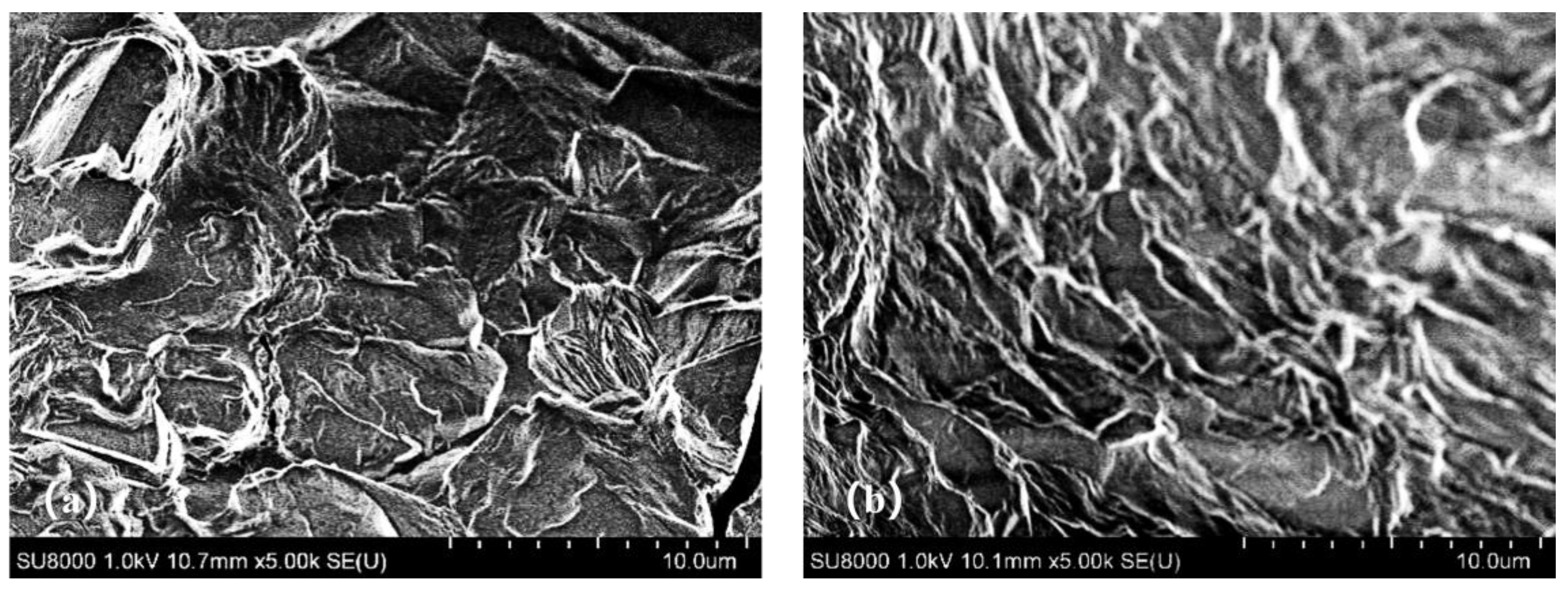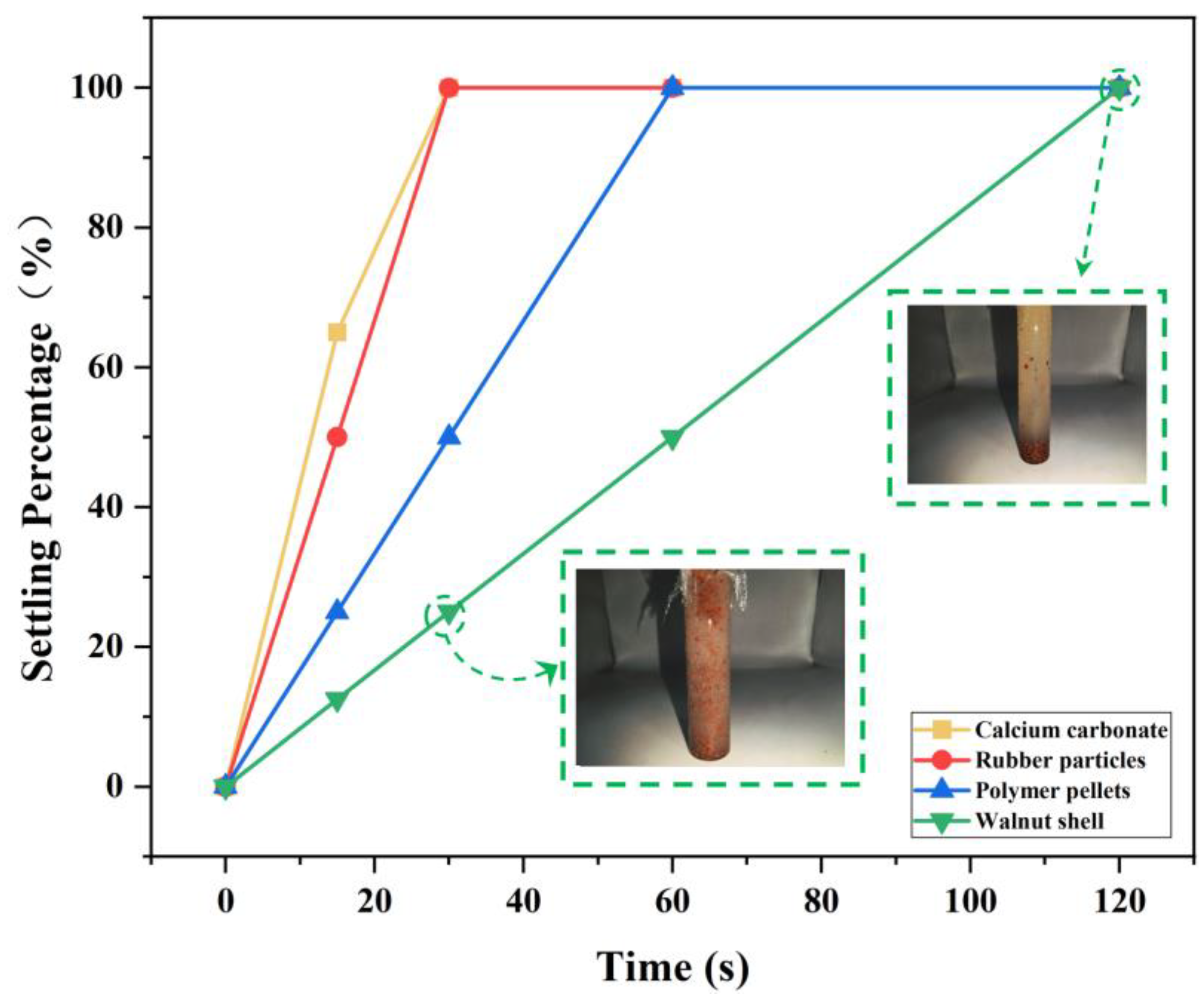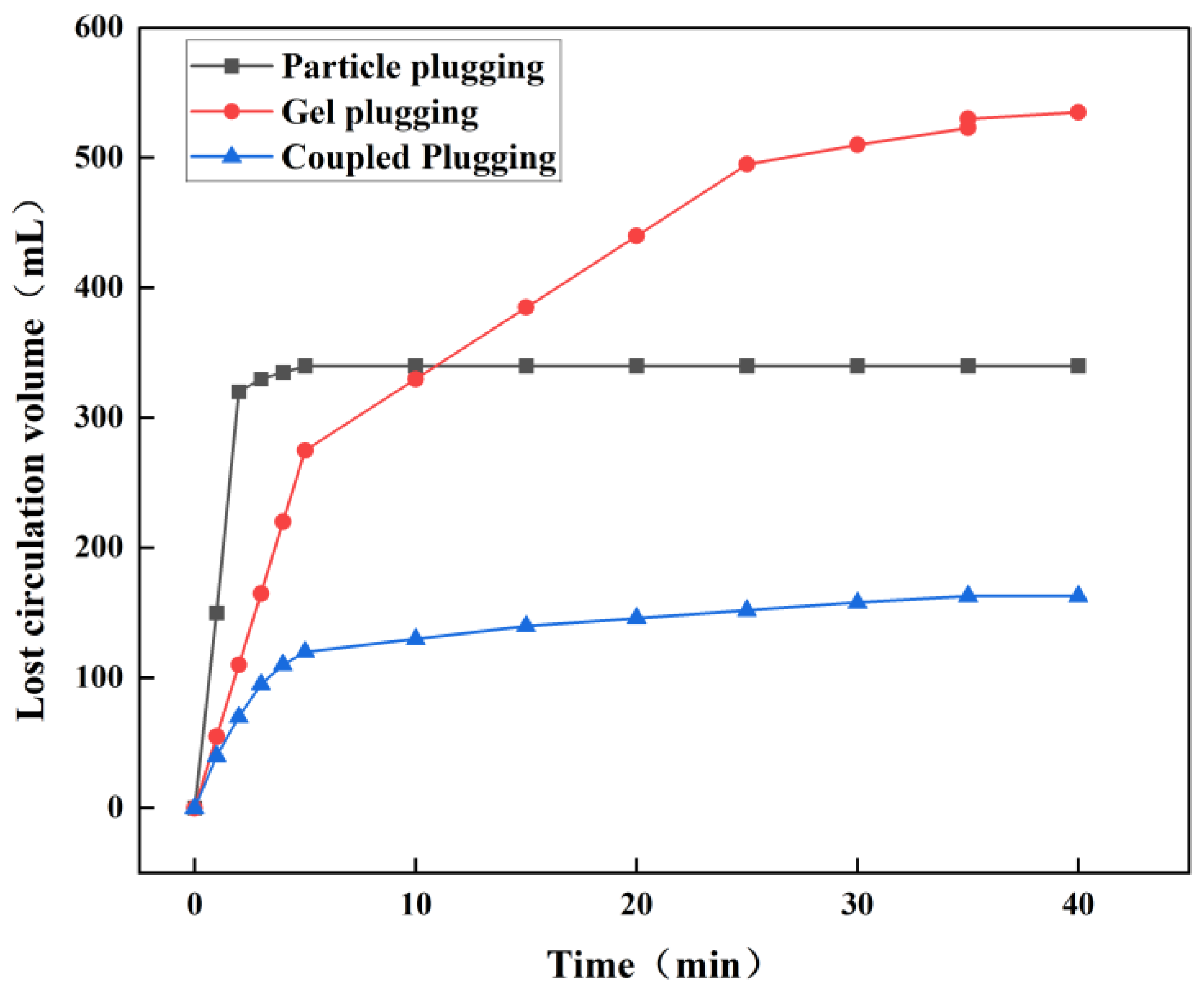1. Introduction
Ultra-deep geological conditions are complex, with extensive multi-scale fractures and cavities, creating harsh engineering environments prone to severe lost circulation and large and medium leaks [
1,
2]. Managing such leaks is challenging, leading to significant drilling fluid loss. Unlike small leaks, severe lost circulation often halts drilling operations and causes sudden wellbore pressure drops [
3]. This significantly impacts drilling safety and cost reduction. For example, the Jialingjiang Formation in western Chongqing’s shale gas block has well-developed fractures and cavities, with frequent severe lost circulation during the third drilling phase. In this area, 50.4% of Jialingjiang Formation wells experience complex lost circulation, averaging 5152.46 m
3 lost per well and 80.99-day treatment cycles. In the Middle East, over 30% of wells drilling carbonate fracture reservoirs experience severe wellbore leaks, with over 50% of lost time attributed to such leaks [
4]. Severe lost circulation, with sudden onset and unpredictability, renders conventional plugging methods ineffective. Efficient, reliable plugging materials and techniques are lacking. Single time plugging success rates are generally low. For example, single time plugging success rates are below 10% in western Chongqing’s Erkaifault and below 25% in Xinjiang’s Shunbei Block [
5]. In Saudi Arabia’s Ghawar Oilfield’s fractured Permian Khuff Formation, single time plugging success rates are below 20% [
6,
7].
Low plugging success rates stem mainly from severe lost circulation (loss rate > 50 m
3/h). In such formations, lost circulation channels are wide and irregular [
8]. In field drilling, the bridging method is widely used for its simplicity and low cost [
9]. However, in large lost circulation channels, bridging agent particles and fibers often fail to effectively retain, bridge, and seal, causing plugging failures. Thus, chemical plugging has emerged as a key supplement for severe lost circulation [
10]. Chemical gels are fluid prior to cross-linking, enabling penetration of diverse lost circulation channels. After solidification, a dense, high strength plug is formed, suitable for sealing complex, irregular fractures [
11,
12]. For example, Ying-Rui Bai synthesized a gel with favorable strength, flexibility, and oil absorption for controlling circulation loss in fractured formations [
13]; Guancheng Jiang developed a high temperature, high strength cross-linked polymer gel (GelHTCMG) with 9.8 MPa pressure-bearing capacity at 150 °C, sealing 3 mm slots [
14]; Binqiang Xie et al. developed a novel HMP-Gel (hydrophobically modified polyacrylamide and polyethyleneimine) with excellent sealing in high-permeability carbonates and 1–3 mm fractures [
15]; Dao et al. proposed a resorcinol-hexamethylenetetramine gel for ultra-high temperature reservoir water control; however, its excessively short gelation time and high strength at extreme temperatures hinder meeting fractured formation sealing requirements, limiting its use [
16].
Thus, despite gel materials being applied in severe lost circulation scenarios with some success, their plugging performance still has significant shortcomings, hindering widespread adoption. On one hand, gel rheological properties are highly sensitive to environmental conditions and easily influenced by temperature and formation water salinity, resulting in premature gelation and failed leak sealing [
17,
18]. On the other hand, gels have limited pressure-bearing capacity and are ineffective for large-scale lost circulation channels. Additionally, good flowability aids entry into lost circulation channels but increases difficulty in controlling gel retention and gelation time [
19].
In recent years, nanoparticles have been widely used to enhance gel performance. Majharul Islam Sujan improved the tensile strength of polyacrylamide hydrogels by more than sixfold by introducing bifunctional silica nanoparticles, significantly enhancing the mechanical properties of the hydrogels [
20]. Hongbin Guo noted that silica nanoparticles can inhibit the oxidative degradation of polymers, and under high temperature conditions, the thermal stability of the gel can remain stable for over 180 days [
21]. Additionally, Camellia Zareie discovered that the hydroxyl groups on the surface of silica nanoparticles can form hydrogen bonds with polyacrylamide (HPAM) molecular chains and enhance the stability of the polymer network structure by filling the polymer network structure [
22]. Wenli Qiao noted that the addition of silica nanoparticles can inhibit excessive entanglement of HPAM molecules, promote their uniform dispersion, and thereby improve the rheological properties of the gel system, resulting in a significant increase in viscosity [
23]. It is evident that the structure and function of nanoparticles play a significant role in overcoming the limitations of traditional gel mechanical properties and environmental adaptability, providing important direction and theoretical support for the practical application of high-performance gel materials under deep-sea high temperature conditions.
To address the limitations of chemical gels in controlling severe lost circulation, this study introduces nanoparticles as functional fillers to investigate their mechanism of action in resisting high temperature-induced structural damage to gels, thereby enhancing the comprehensive mechanical properties and rheological performance of the gel network system. Based on this, walnut shells were selected as bridging particles and combined with chemical gels to evaluate the application potential of the gel-bridging coupled plugging system in severe lost circulation formations. Through fracture plugging experiments, it was revealed that bridging particles act as a supporting skeleton within lost circulation channels and effectively retain the gel, while the gel fills the gaps between particles, enhancing the plugging structure’s density. This innovative combination of a nano-enhanced gel-bridging coupled plugging system holds promise for providing a more efficient and feasible technical approach for on-site remediation of severe lost circulation formations.
2. Experimental Section
2.1. Materials and Instruments
The polymer gel agent used in this experiment is water-soluble polyvinyl alcohol (PVA, medium polymerization degree), supplied by ShanghaiMcLean Biochemical Technology Co., Ltd., China to balance the appropriate solution viscosity and post-gelation mechanical strength. Crosslinking agents include 2 wt% glutaraldehyde, 1 wt% borax (sodium tetraborate), and 1 wt% sodium tripolyphosphate, all purchased from ShandongLonghui Chemical Co., Ltd., China Filler materials are 1 wt% starch, 1 wt% montmorillonite, and 1 wt% hydrophilic nanosilica, all supplied by Jingzhou Jiahua Technology Co., Ltd., China The water-based drilling fluid used is the potassium-based polyacrylamide system commonly used in the Tarim Oilfield, Xinjiang, with a density of 1.50 g/cm3.
During the experiment, gel stirring was conducted using a JJ-1 timer-controlled electric stirrer (Shanghai Puchun Metrology Instrument Co., Ltd., China); the VCX-800 model (Sonics & Materials, Inc., Newtown, CT, USA) was used as the ultrasonic dispersion equipment; and temperature control was achieved using an HH series digital display constant temperature water bath (Changzhou Guoyu Instrument Manufacturing Co., Ltd., China). Gel mechanical properties were tested using an MD-NJ5 gel strength tester (Linan Fengyuan Electronics Co., Ltd., China) and a DFC-0712B dual-cylinder pressure thickening tester (Shenyang Jinouke Petroleum Instrument Technology Development Co., Ltd., China). Rheological parameters were measured using an LVDV-11+P Brookfield viscometer (Jingzhou Jiahua Technology Co., Ltd., China). Gel properties under thermal aging conditions were evaluated using the XGRL-4A high temperature roller heating furnace (Qingdao Chuangmeng Instrument Co., Ltd., China). Fracture simulation plugging tests were conducted using the simulated natural fracture plugging instrument manufactured by Jingzhou Talin Mechanical and Electrical Equipment Manufacturing Co., Ltd., China.
2.2. Preparation of Particle-Reinforced Gel
In recent years, acrylamide copolymer crosslinked gels have seen widespread use in oilfield plugging. However, their amide groups hydrolyze at high temperatures, converting to carboxylic acids, causing polymer particles to harden continuously and lose plasticity. In contrast, polyvinyl alcohol (PVA), a non-ionic polymer, resists high temperature hydrolysis, preventing hardening failure. Its low toxicity, water dilution resistance, and excellent water resistance enable slight gel swelling after prolonged water immersion, enhancing plugging effectiveness. Additionally, gel-rock pore wall bonding strength is significantly enhanced post-gelation. Based on the aforementioned advantages, water-soluble polyvinyl alcohol (PVA) was selected as the primary agent. Considering the gel’s initial fluidity and suspension requirements, PVA’s molecular weight range was set to 120,000–150,000. PVA in this range exhibits appropriate viscosity, enabling suspension of filler materials and bridging particles while preserving favorable pumping fluidity. Meanwhile, following crosslinking, a network structure with adequate mechanical strength is formed, satisfying the pressure-bearing capacity for large fracture plugging.
After determining that water-soluble PVA (molecular weight 120,000–150,000) would be used as the main agent, the following steps were taken to prepare the particle-reinforced gel: first, PVA was placed in an 80 °C water bath and stirred to full dissolution; simultaneously, 1 wt% starch, montmorillonite, or hydrophilic nanosilica particles were physically stirred for 4 h. Subsequently, an ultrasonic device with a power of 20 kHz and 400 W was used to disperse the filler for 1 h to obtain a uniformly dispersed filler suspension; this suspension was slowly added to the PVA solution and stirred at 80 °C for full filler dispersion. Finally, a crosslinking agent (e.g., glutaraldehyde, borax, or sodium tripolyphosphate) was added at the preselected ratio and pre-cured in an 80 °C water bath for 1–2 h to adjust viscosity and ensure pumpability. Subsequently, samples were transferred to a high temperature roller heating furnace for 80 °C thermal aging (8 h), completing final curing to produce high strength, gelation time-controlled particle-reinforced PVA gel.
2.3. Gel Properties Evaluation Method
2.3.1. Gel Gelation Time Determination
The gelation time of the gel at 80 °C was determined using the DFC-0712B dual-cylinder pressure thickening tester. The sample was placed into the thickener cylinder, the rotor speed was set in accordance with ASTM D4683-17 standards, the time required for viscosity to transition from low (pumpable state) to high (gel state) was recorded, and the average of three tests was taken as the gelation time [
24].
2.3.2. Gel Strength Test
The maximum force required for the probe to penetrate the gelled sample at a constant speed (1 mm/s) was measured using the MD-NJ5 gel strength tester. Each group of samples was tested after being allowed to stand at room temperature for 24 h, with the test repeated five times. The average value and standard deviation were then calculated to evaluate the gel’s puncture resistance and toughness.
2.3.3. Rheological Characterization
Viscosity changes of the gel in each base formulation at 25 °C under different shear rates (17–1021 s−1) were measured using the LVDV-11+P Brookfield viscometer. Viscosity-shear rate curves were analyzed to determine the gel’s pseudoplastic or Bingham plastic characteristics, thereby revealing its rheological behavior during wellbore pumping and within lost circulation channels.
2.3.4. Thermal Stability Evaluation
Gel samples from each base formulation were cut into cylinders (25 mm diameter × 20 mm height), and their initial gel strength was first determined; they were then placed in an XGRL-4A high temperature roller heating furnace and subjected to rolling aging at temperatures ranging from 80 °C to 120 °C (with one experimental set conducted every 5 °C) for 4 h. After removal, gel strength was measured again and compared with the initial value to evaluate mechanical stability under high temperature conditions. Subsequently, the removed samples were aged at 120 °C for 60 h, with the current-to-original volume ratio recorded every 5 h to assess the thermal stability of gels from each base formulation under long-term high temperature conditions.
2.3.5. Temperature Sensitivity Analysis
Viscosity changes of the gel system at different temperatures were tested using a Brookfield viscometer at a constant shear rate of 17 s−1. The total test duration was 250 min, with temperatures ranging from 20 °C to 140 °C. Measurements were taken every 10 min, and data points with significant changes were selected to plot the resulting curve. This was performed to simulate and evaluate whether the gel system could maintain a low-viscosity, fast-flowing state prior to being pumped into the target layer.
2.3.6. Contamination Resistance Testing
To simulate the effects of on-site mud contamination on the gel system, water-based drilling fluids with 5 wt%, 10 wt%, 15 wt%, and 20 wt% (mass fraction) concentrations were mixed with the ungelified PVA–filler–crosslinker system at a 1:1 volume ratio. After thorough mixing, the gelation time of the contaminated gel and its strength 24 h post-gelation were measured at 80 °C to assess the inhibitory effect of drilling fluid components on gelation behavior.
2.3.7. Microstructural Analysis
The morphology of gel systems without nanomaterials and those with nanomaterials was observed and compared using a scanning electron microscope (field emission type, Hitachi SU8010, Hitachi Ltd., Tokyo, Japan) after gelation at 80 °C and 24 h aging. Prior to testing, gel samples were freeze-dried for 24 h to remove moisture and sputter-coated with gold to enhance conductivity. The microscopic pore structure, network crosslinking morphology, and filler distribution were observed, and the effects of nanomaterials on the gel’s microstructural density and pore uniformity were analyzed.
2.3.8. Selection of Optimal Bridging Particles
The candidate bridging agent (particles) at a concentration of 1 wt% was added to the PVA solution. Stirring was performed using a JJ-1 timer-controlled electric stirrer at 500 rpm for 15 min. The mixture was then allowed to stand, and settling time and dispersion uniformity were observed at 25 °C. Based on particle suspension duration and final settling rate, the solid-phase material most suitable for synergistic suspension and bridging with the gel system was selected.
2.3.9. Simulated Natural Fracture Plugging Experiment
As shown in
Figure 1, a natural fracture high temperature and high-pressure loss evaluation device manufactured by Jingzhou Tailin Petroleum Technology Co., Ltd., Jingzhou City, China was utilized, equipped with a natural sandstone flat fracture module (7 mm width) to simulate a severe lost circulation formation environment. Under conditions of 120 °C, 5 MPa pore pressure, and 10 MPa downhole pressure, pre-prepared gel-bridge-coupled plugging fluid was injected, with leakage rates recorded over time. Sealing efficiency and stability time were compared among single-use bridge particles, single-use gel, and composite systems to quantitatively assess the field application potential of coupled plugging technology.
3. Mechanism of Action
In complex lost circulation formations, conventional chemical gels, due to their low initial viscosity, tend to flow rapidly upon entering high-permeability or fractured channels, making effective sealing difficult. Particularly in high temperature environments, conventional gels have limited pressure-bearing capacity, rendering them prone to being squeezed into deeper channels or expelled, thus impairing the plugging effect. To address this, nanoparticles are introduced in this paper to overcome the issues of insufficient strength and poor temperature resistance in conventional gels, and a bridging agent is combined with the gel to compensate for the deficiencies of single materials in complex lost circulation channels, such as poor retention and weak pressure-bearing capacity. Through the synergistic action of multiple mechanisms, excellent plugging performance is achieved by the two [
25].
(1) Mechanism of action of nanomaterials in enhancing gel properties
The mechanism by which nanosilica enhances the mechanical properties and temperature resistance stability of the gel is illustrated in
Figure 2. Nanosilica dispersed within the gel system can interact with polymer molecules via hydrogen bonding, thereby inhibiting their degradation at high temperatures [
26]. Furthermore, due to the hydrophilic nature of hydroxyl groups on the surface of nanoparticles, the dehydration of the gel at high temperatures can be delayed, allowing the gel system to retain more moisture to resist high temperature effects. Meanwhile, the combination of nanosilica with polymer molecules improves the originally disordered distribution of polymer molecules within the gel system, forming a more uniform polymer network and significantly enhancing gel strength. In addition, during the crosslinking process, some nanosilica forms aggregates that fill the pores of the network structure, increasing its compactness and thereby further enhancing the strength of the network structure [
27].
(2) Gel-bridging coupled plugging mechanism of action
Figure 3a illustrates that conventional chemical gels, due to their low initial viscosity, flow rapidly upon entering fracture channels, rendering effective plug formation difficult.
Figure 3b illustrates the mechanism of gel-bridging coupled plugging. In the initial stage, uncrosslinked gel injected into high-permeability fractures, due to its low viscosity, is prone to leakage and loss with the fluid. Without a pilot structure, it is difficult for the gel to remain, expand, and gel within the channel. By adding bridging particles (rigid large particles, elastic micro-particles) to the gel system, a multi-scale physical plugging framework is first formed, which serves to achieve rapid initial plugging and flow rate regulation. Particles become embedded, bridge, and deposit within the fracture, particularly at fracture openings or in high-permeability zones, forming an initial “particle bridge plug” that effectively reduces local flow velocities and pressure gradients [
28]. The subsequently injected gel acts as an “adhesive,” adhering to particle surfaces and enveloping interparticle gaps to “bond” discrete particles into a cohesive whole, thereby forming a continuous, dense elastic network structure. The aforementioned coupled plugging structure incorporates a dual mechanism of “rigid support + elastic bonding,” effectively enhancing the retention capability and high-pressure resistance of the plugging section. Therefore, gel-bridging coupled plugging not only addresses the issue of single gels struggling to retain effectively in high lost circulation channels but also significantly improves structural stability and mechanical properties post-gelation, demonstrating excellent adaptability to severe lost circulation formations and field application potential [
29].
4. Discussion of Experimental Results
4.1. Selection of Crosslinking Agents
When severe lost circulation occurs in the wellbore, control of the gel’s gelation time via gel plugging is essential to ensure adequate coverage of the severe lost circulation area by the gel. If gelation time is too short, the gel may gel before reaching the lost circulation area, preventing it from reaching the affected zone. If gelation time is too long, the gel may gel outside the loss area, resulting in poor plugging performance. The type of crosslinking agent significantly influences the gel’s gelation time [
30].
Polyvinyl alcohol gel (PVA gel) can be prepared using various crosslinking agents and methods. The selection of crosslinking agents and methods affects the gel’s performance and characteristics. Glutaraldehyde, borax, and sodium tripolyphosphate will be used as crosslinking agents in the experiment to determine the system’s gelation time. Additionally, the ratio of pH adjusters will be adjusted to influence gelation time, thereby screening for the crosslinking agent with the most suitable gelation time. The base formulation used is distilled water + 10% PVA + pH adjuster + crosslinking agent.
As shown in
Table 1, the use of different crosslinking agents does affect the gelation time of polyvinyl alcohol (PVA) gel; notably, when glutaraldehyde is used as the crosslinking agent, gelation time is prolonged, and this can be controlled by adjusting the pH value. As shown in
Figure 4, the maximum gelation time can reach 110 min. A longer gelation time allows the gel to enter the fracture from the wellbore smoothly, covering the entire lost circulation channel and forming an effective sealing structure. It also provides an extended time window for on-site construction.
4.2. Regulation of Gel Properties
In addition to crosslinking agent selection, factors such as polymer main agent amount, crosslinking agent concentration, and pH regulator dosage also influence the gel’s gelation time and mechanical properties. A composite pH regulator system using citric acid and sodium citrate was employed in this study, and orthogonal experiments (L9 (3
3)) were conducted to design a total of nine experimental groups. The primary factors under investigation included polymer matrix dosage, crosslinking agent dosage, and the citric acid-to-sodium citrate ratio. The orthogonal experimental factor level table and orthogonal experimental results analysis table are presented in
Table 2 and
Table 3.
The most suitable gel formulation for rotation was comprehensively determined by analyzing the effects of main agent concentration, crosslinking agent concentration, and pH regulator ratio on system gelation time, along with testing gel strength. Analysis of the orthogonal experimental results shows that range data comparison indicates factor C has the largest range value (75.66), making the citric acid-to-sodium citrate ratio the most significant factor influencing PVA gel gelation time. pH values can influence the chemical environment of the crosslinking reaction, thereby enabling precise control of gelation time. Under different pH conditions, reaction rates between the crosslinking agent and polymer vary. Based on gel strength analysis, Experiment 6 was selected as the optimal formulation. Excessively high polymer concentrations may result in excessive solution viscosity, impacting gelation time and flowability during injection. The optimal main agent concentration is controlled at 10%. As shown in
Table 3, the gelation time of this polymer gel can be controlled between 20 and 120 min, enabling timely adjustment of gelation time during construction based on-site conditions.
4.3. Selection of Optimal Gel Fillers
As shown in the orthogonal experiment results in
Table 3, the original strength of PVA gel ranges from 4 to 22 N. To achieve higher strength, the gel’s strength was enhanced in this study by adding filler materials. After a review of relevant literature, 1% montmorillonite, starch, and nanosilica were selected as filler materials for experimentation, and gel strength was measured. Based on previously determined experimental conditions, the base formulation was 500 mL distilled water + 1% nanosilica + 10% PVA + 3% citric acid + 9% sodium citrate + 2% glutaraldehyde. The experimental results are presented in
Figure 5.
As shown in
Figure 5, the use of nanosilica as the gel filler material results in better enhancement of gel strength. Nanosilica is uniformly dispersed in the aqueous solution via ultrasonication, followed by the complete dissolution of PVA gel in the solution, forming a stable dispersion system that effectively enhances the gel’s mechanical and functional properties. As observed in the physical sample images, the montmorillonite-containing gel exhibits a jelly-like consistency and is easily crushed. The nanosilica-containing gel exhibits better elasticity and greater toughness, rendering it less prone to crushing [
31]. The use of nanomaterials to enhance gel strength is a common method; for this purpose, stable dispersion of nanomaterials within the gel is essential. In the experiment, nanosilica exhibited excellent dispersion in the PVA polymer gel. Therefore, nanosilica was selected as the filler material. The resulting basic gel formulation was distilled water + 10 wt% PVA particles + 3 wt% citric acid + 9 wt% sodium citrate + 1 wt% nanosilica + 2 wt% glutaraldehyde.
4.4. Selection of Optimal Gel Filler Addition Amount
To determine the appropriate amount of filler material, four basic formulations were established to investigate changes in gel properties. These included a basic formulation without nanosilica, a basic formulation with 0.5 wt% nanosilica, a basic formulation with 1.0 wt% nanosilica, and a basic formulation with 1.5 wt% nanosilica.
(1) Evaluation of gel rheological properties
As shown in
Figure 6, both the polymer gel before and after nanosilica addition exhibit shear-thinning characteristics, indicating that the prepared gel system can maintain a low viscosity and rapid flow state prior to being pumped to the target layer. A comparison of
Figure 6a,b reveals that the system’s viscosity increases significantly after nanosilica addition, with the decreasing trend becoming more gradual. This indicates that during the crosslinking reaction, nanosilica can form hydrogen bonds with polymer molecules and arrange themselves in an ordered manner within the polymer network structure, thereby significantly enhancing the strength of the gel structure [
30].
(2) Evaluation of the thermal resistance of the gel
Figure 7 shows four base formulations exhibit slight, non-significant gel strength decreases with increasing temperature. However, nanosilica-containing gels exhibit significantly higher strength than those without. This arises from nanosilica acting as a crosslinking agent during crosslinking, interacting with polymers to form a joint network and enhance overall gel strength.
Figure 8 shows gels without nanosilica shrink in volume over time at 120 °C aging. This reflects polymer thermal degradation at high temperatures, causing gel shrinkage and volume decrease [
31]. However, nanosilica addition slows the gel’s volume change. This is due to nanosilica inhibiting polymer thermal degradation and forming hydrogen bonds with system water, resisting high temperature evaporation, and improving thermal stability.
Increasing nanosilica concentration increases crosslinking particles, raising crosslinking density and improving the gel system’s strength and thermal stability [
32]. At 1.0 wt%, gel strength and volume changes stabilize, indicating saturated crosslinking between nanosilica and polymers. Overall, 1% nanosilica addition leads to high temperature gel strength decrease but retention above 30 N, meeting design requirements. Thus, a 1 wt% nanosilica base formulation was selected for subsequent experiments to investigate gel system and particle-gel composite properties.
4.5. Analysis of Temperature Sensitivity of Nanomaterials-Reinforced Gel Systems
Viscosity changes of the gel system with and without 1.0 wt% nanosilica under a specific temperature gradient are shown in
Figure 9. The results indicate that as temperature increases from 20 °C to 140 °C, the viscosity of the gel system without nanosilica is significantly temperature-dependent, with a sharp viscosity decrease observed between 50 and 150 min. In contrast, the viscosity of the nanosilica-added gel system decreases slightly, with no significant overall change. The gel’s overall viscosity remains between 33,000 and 47,000 mPa·s, indicating that nanosilica addition can partially resist high temperature damage to the gel system’s network structure 34. At its lowest viscosity, the gel can carry bridging particles into the fracture, facilitating fracture filling with bridging particles, while thickening at the leakage site to significantly reduce fluid loss.
4.6. Contamination Resistance of Nanomaterials-Reinforced Gel Systems
As shown in
Figure 10, with increasing mud concentration, the gel system’s strength and gelation time change minimally at concentrations below 10.0 wt%. However, as concentration increases from 10% to 20%, the gel system’s strength changes by 12.8% and 17.6%, respectively, while gelation time changes by 53.1% and 46.6%, respectively. This indicates that water and solid particles in the mud significantly slow the crosslinking reaction rate while disrupting the gel system’s network structure, thereby affecting gel strength. To address prolonged gelation time, the pH of the gel solution can be adjusted by modifying the citric acid-to-sodium citrate ratio to control gelation time. A longer gelation time allows the gel system to enter the fracture from the wellbore smoothly, cover the entire lost circulation channel, and form an effective sealing structure. It also provides an extended time window for on-site construction [
33]. Furthermore, experimental results indicate that mud intrusion has minimal impact on gel system strength. Although increased mud intrusion gradually reduces gel system strength, at 20% intrusion, the gel system strength remains at 30 N, meeting sealing requirements and demonstrating excellent contamination resistance of the gel system.
4.7. Microscopic Analysis of Nanomaterials-Reinforced Gel Systems
The scanning electron microscope microstructures of gel systems with and without nanosilica particles are shown in
Figure 11. As shown in
Figure 11a, the surface of the gel system without nanosilica particles is relatively rough, with large pores and irregular structures. In contrast,
Figure 11b shows that following the introduction of nanosilica particles, the gel system exhibits a more uniform network structure. This indicates that nanosilica particles are uniformly distributed within the gel system network, where they serve a filling and reinforcing role, resulting in an overall finer and smoother structure [
34].
4.8. Optimal Bridging Particles Compatible with Gel Systems
In the coupled bridging and gel plugging system, the primary function of bridging particles is to form bridges within lost circulation channels, thereby facilitating the plugging of these channels by the gel. Therefore, the suspension performance of bridging particles is of particular criticality. If the suspension performance of bridging particles is poor, they may not be effectively transported into lost circulation channels, and significant variations in plugging slurry concentration may occur between the front and rear sections [
33]. In this study, walnut shells, calcium carbonate particles, rubber particles, and polymer particles were selected as particulate materials for assessing suspension performance. The particle size distribution was optimized via a particle grading method, with the first-stage bridging particles exhibiting a particle size range of 4–6 mm (representing approximately 65% of the total) and the second-stage bridging particles exhibiting a particle size range of 2–4 mm (representing approximately 35% of the total).
The experimental results are presented in
Figure 12. After stirring, calcium carbonate and rubber particles settled completely within 30 s, whereas polymer particles settled completely within 60 s. Due to their lowest density among plant materials and strong suspension capacity, walnut shells exhibited a settling rate of only 50% at 60 s and complete settling by 120 s, indicating the best settling stability. Therefore, walnut shells were ultimately selected as the bridging particles for the coupled plugging method, with a gel system introduced to enhance the strength and shear resistance of the plugging structure [
34].
4.9. Evaluation of Gel-Bridging Coupled Plugging Method Under Simulated Severe Lost Circulation Conditions
The fracture plugging simulation experiment is designed to simulate the plugging state of gel in a geological formation environment, thereby assessing the quality of plugging in lost circulation channels and providing validation for the actual simulation process of plugging fractured leaking formations. A fracture plugging simulation device manufactured by Hai’an Petroleum Technology Co., Ltd. is used to evaluate the plugging effect. The fracture module is made of steel and features an equal-width fracture structure with a width of 7 mm. Plugging results are indicated by pressure-bearing capacity and lost circulation volume. According to petroleum industry standards, fractures ranging from 3 to 5 mm in width are classified as medium-width fractures. Conventional materials exhibit relatively low lost circulation rates for such fractures. Specifically, a 3 mm fracture results in a lost circulation rate of 3 to 5 m
3/h, while a 5 mm fracture has a lost circulation rate of less than 10 m
3/h. A 7 mm fracture represents the maximum fracture width that conventional materials can effectively plug (fractures wider than 7 mm typically require coupled plugging using multiple materials). However, at a 7 mm fracture width, conventional materials may fail due to unstable bridging, insufficient strength, or low density of the plugging layer, leading to severe lost circulation with rates exceeding 50 m
3/h. Therefore, testing the plugging effectiveness of this fracture size can provide a reference for most severe lost circulation scenarios in deep reservoirs. Under 7 mm fracture conditions, different plugging methods were used to plug fractures. The plugging capacity of different methods was evaluated via lost circulation volume and pressure-bearing capacity measurements during fracture plugging. Selected methods included bridging plugging, gel plugging, and coupled plugging [
35,
36].
(1) Relationship between lost circulation volume and time under three leak plugging methods for a 7 mm fracture.
(2) Relationship between downward pressure and time for three leak plugging methods under a 7 mm fracture
Figure 13 and
Figure 14 show particle plugging exhibits a rapid pressure rise within 5 min, with particles quickly forming a supporting skeleton at the fracture entrance. However, loose particle bridging causes rapid increases in lost circulation volume. Pressure stabilizes at 5.5 MPa with lost circulation volume at 340 mL, as particles fill skeleton gaps to form a denser plugging layer. However, large particles primarily fill the fracture entrance, risking re-leakage during reconstruction [
37]. Gel plugging initially involves uncrosslinked gel with low flow resistance and higher lost circulation volume. Gel crosslinking increases over time, increasing flow resistance. At 5 min, lost circulation volume is 275 mL (slowing rate); at 25 min, it reaches 495 mL and stabilizes.
Figure 14 shows pressure rises after 20 min, indicating gel network formation and effective plugging. Coupled plugging involves initial particle skeleton formation, obstructing gel flow with pressure rising slowly to 0.7 MPa at 5 min. Crosslinking increases over time, with particles filling remaining spaces. At 8 MPa, lost circulation volume stabilizes at 163 mL with pressure stabilization, indicating a stable composite sealing layer [
38].
A comparison of the plugging performance of different leak plugging methods reveals that in bridging plugging, particle bridging within the fracture is of poor quality, resulting in weak pressure-bearing capacity, a loose plugging layer, and a high likelihood of re-leakage. This aligns well with actual on-site conditions. The gel plugging method also exhibits insufficient pressure-bearing capacity in large fractures, indicating that gel alone lacks adequate compressive and shear resistance within such fractures. Mechanical strength is enhanced in the coupled plugging method by incorporating particles into the gel system to form more robust plugging segments. This highlights the critical role of physical bridging particles within the gel system.
5. Conclusions
1. The gel-bridging coupled plugging technology combines the advantages of gel and bridging plugging approaches. Its mechanism is summarized as follows: bridging particles act as a supporting skeleton, reducing local flow velocity by minimizing lost circulation channels; nanosilica introduction improves the gel’s polymer network structure, thereby increasing viscosity, while their synergistic effect enhances gel retention capacity. The gel retained in particle interstitial spaces further enhances plugging structure density, ultimately resulting in a dense, high-pressure resistant coupled plugging effect.
2. Nanosilica enhances the gel system’s thermal stability, mechanical properties, and rheological properties, demonstrating a multi-mechanism synergistic effect: gels without nanosilica undergo volume shrinkage, lose pressure-bearing capacity, and exhibit significant viscosity changes at high temperatures. Nanosilica, via binding with polymers and water molecules, resists high temperature gel structure damage; void filling in the gel network also improves the system’s mechanical and rheological behavior. Experimental results show that at 120 °C aging temperature, gel strength reaches 30 N, and overall viscosity is maintained at 33,000–47,000 mPa·s, with significant performance improvements.
3. The synergistic advantages of the coupled system were validated via a 7-mm fracture plugging experiment: walnut shell bridging particles rapidly form a bridge in lost circulation channels, creating a supporting skeleton to reduce flow velocity, while the gel integrates discrete particles into a continuous, dense plugging structure. Final plugging strength exceeded 8 MPa, and within 40 min, cumulative lost circulation volume was only 163 mL, outperforming the plugging performance of single plugging approaches.
